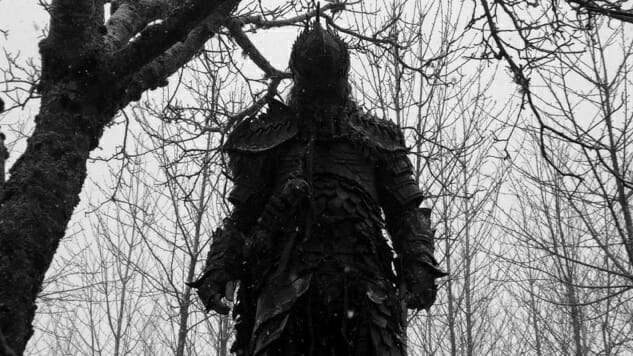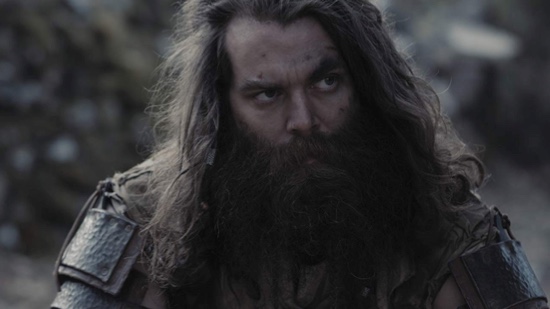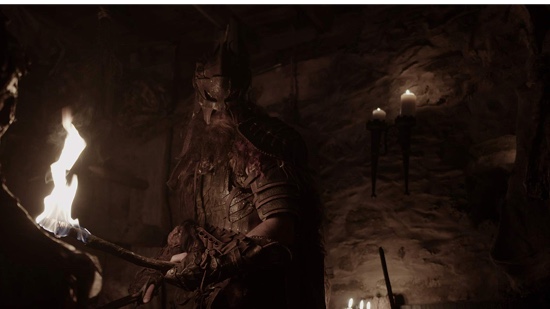
With the upcoming J.R.R. Tolkien biopic and the prospect of even more, even nerdier Lord of the Rings stories about to air on television, it’s fair to wonder why one of Tolkien’s genre fiction contemporaries has not gotten a bit more exposure. There’s been something of a half-hearted attempt to adapt the more famous works of author Robert E. Howard into film in the last decade or so, with 2009’s Solomon Kane and 2011’s Conan the Barbarian. Neither made a big impression. It’s a shame, because some good old-fashioned mud-and-blood violence would be a welcome change of pace in light of the last few years of fantasy movies, which have bizarrely chosen to keep trying to rehash Peter Jackson’s interpretation of Middle Earth, even if they’re adapting properties that have absolutely nothing to do with epic fantasy war.
With a new Red Sonja movie languishing in production hell, I did not expect 2019 to give us the best actual sword-and-sorcery movie I’ve seen in years, nor for it to be a mostly one-man show by a director whose most well-known work so far is a campy horror movie about a murderous Thanksgiving turkey spirit. Yet, here is The Head Hunter, and yes, it is correctly spelled as two words in this case.

In some medieval age, seemingly far from civilization, a man (Christopher Rygh) lives in the wilderness with his daughter (Cora Kaufman). Neither are given names. In the entire film there are maybe just enough lines of dialogue to count on the fingers of one hand. In 72 minutes, there is far less to tell than there is to show.
We are shown that the father (as he is named in the film’s credits) lives in a world stalked by what have to be legions of unnatural predatory creatures. His daughter was taken by one in a scene we are never shown, and when we see him again, we discover that he’s become a man of habit. That habit just happens to be getting up in the morning, responding to a call from some distant authority to go hunt a nightmarish creature, hunting down and decapitating that creature, and then impaling its head on his wall to join the rest of his collection.
This is where high fantasy would bust out lore and world-building and all sorts of grandiosity. Thank Crom that Downey doesn’t care about any of that, or at least doesn’t care to waste dialogue on it. We know from one shot of him throwing a handful of gold into an overflowing chest that he is both paid for his work and doesn’t care to spend it. We know this is a world of inscrutable magic because Rygh keeps himself vertical by smearing his wounds with the foulest of healing potions and consults an old tome before donning his scary-face helmet to go a-slayin’.
And we know, in the tense moments when we see his eagerness to charge off to the slaughter, that his carelessness and single-mindedness are going to have repercussions.

The Head Hunter will disappoint if the viewer goes into it expecting to witness a lot of battle. Nearly all the violence happens off screen, and we’re treated to the gruesome aftermath, often involving Rygh dragging himself home with just enough time to apply that awful healing potion—which he makes by what looks to be boiling the corpses of animals into black sludge—and pass out from pain before waking up the next day to go out and impale another monstrous head on his wall. By the time he gets the fateful Wanted notice for the same creature that killed his daughter, we’ve settled into his routine and know, with dread, how it must go wrong.
That’s also where the filmmaking takes a turn as sharp as the story itself. Rygh triumphs, but then it turns out his disembodied quarry isn’t quite dead. What follows are first-person camera swoops and shock sequences that feel right at home in a movie like Evil Dead 2. The Head Hunter has become the head hunted.

Jordan Downey directed ThanksKilling (2009) and its sequel ThanksKilling 3 (2012) (The plot of the latter centers around the quest for the world’s last remaining copy of the fictional movie ThanksKilling 2.) The movies star Downey as the voice of a homicidal turkey named “Turkie,” and feature the tagline “Gobble Gobble, m*therf***er.” They are intentionally, gloriously bad, the perfect centerpiece for a drunk evening with friends.
They’re also movies that are clearly made with limited resources and know what sort of story they have to tell within those limitations. It’s not really surprising that some of those same instincts work in Downey’s favor in this movie. The Head Hunter eschews most graphic violence and crazy battle scenes to tell a tighter story that is about Rygh’s pain and obsession. It still evokes the low and brutal storytelling philosophy of Robert E. Howard, hinting at a wider world of ghoulish dangers and the hard men who fight with them, but it works within its budget and focuses on what it can afford to show, all with a tight script and a runtime that does not overstay the premise’s welcome.
It doesn’t artificially pad its runtime with bullshit like some old doomsayer showing up randomly to taunt the hero, another character or three who just exist to get killed, or drippy flashbacks with the daughter that we would not need to establish the protagonist’s motivations. The one mark against it is that even at 72 minutes it feels as if perhaps it could stand to trim a little bit more, but then it would be in the awkward territory of being too long for a short film and not long enough for a feature-length film.
That’s ultimately what rubs me the wrong way about the other “dark” or “low fantasy” offerings of recent years: They just want to put in too much when really, less is more. If The Head Hunter had come in with a bigger budget and a different director, there would have been all sorts of attempts at injecting silly lore into this pure and primal tale. It may feature just one or two fight scenes, no cackling wizards or captive princesses, but it manages to evoke that spirit while also telling a straightforward horror story. It makes me excited to see what Downey tries next.
Kenneth Lowe stares also into you. You can follow him on Twitter and read more of his writing at his blog.